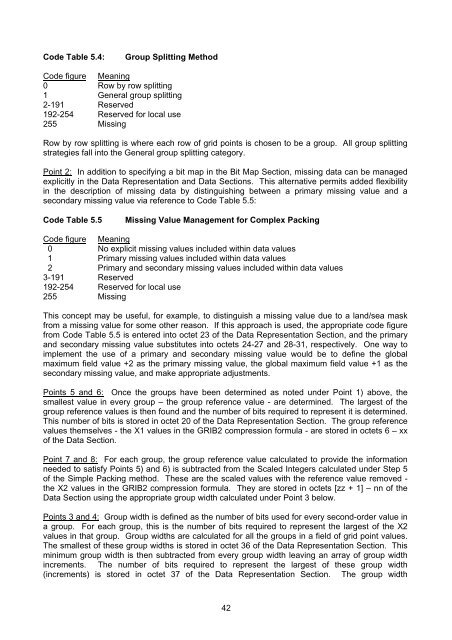Guide to WMO Table Driven Code Forms
Guide to WMO Table Driven Code Forms
Guide to WMO Table Driven Code Forms
Create successful ePaper yourself
Turn your PDF publications into a flip-book with our unique Google optimized e-Paper software.
<strong>Code</strong> <strong>Table</strong> 5.4: Group Splitting Method<br />
<strong>Code</strong> figure Meaning<br />
0 Row by row splitting<br />
1 General group splitting<br />
2-191 Reserved<br />
192-254 Reserved for local use<br />
255 Missing<br />
Row by row splitting is where each row of grid points is chosen <strong>to</strong> be a group. All group splitting<br />
strategies fall in<strong>to</strong> the General group splitting category.<br />
Point 2: In addition <strong>to</strong> specifying a bit map in the Bit Map Section, missing data can be managed<br />
explicitly in the Data Representation and Data Sections. This alternative permits added flexibility<br />
in the description of missing data by distinguishing between a primary missing value and a<br />
secondary missing value via reference <strong>to</strong> <strong>Code</strong> <strong>Table</strong> 5.5:<br />
<strong>Code</strong> <strong>Table</strong> 5.5 Missing Value Management for Complex Packing<br />
<strong>Code</strong> figure Meaning<br />
0 No explicit missing values included within data values<br />
1 Primary missing values included within data values<br />
2 Primary and secondary missing values included within data values<br />
3-191 Reserved<br />
192-254 Reserved for local use<br />
255 Missing<br />
This concept may be useful, for example, <strong>to</strong> distinguish a missing value due <strong>to</strong> a land/sea mask<br />
from a missing value for some other reason. If this approach is used, the appropriate code figure<br />
from <strong>Code</strong> <strong>Table</strong> 5.5 is entered in<strong>to</strong> octet 23 of the Data Representation Section, and the primary<br />
and secondary missing value substitutes in<strong>to</strong> octets 24-27 and 28-31, respectively. One way <strong>to</strong><br />
implement the use of a primary and secondary missing value would be <strong>to</strong> define the global<br />
maximum field value +2 as the primary missing value, the global maximum field value +1 as the<br />
secondary missing value, and make appropriate adjustments.<br />
Points 5 and 6: Once the groups have been determined as noted under Point 1) above, the<br />
smallest value in every group – the group reference value - are determined. The largest of the<br />
group reference values is then found and the number of bits required <strong>to</strong> represent it is determined.<br />
This number of bits is s<strong>to</strong>red in octet 20 of the Data Representation Section. The group reference<br />
values themselves - the X1 values in the GRIB2 compression formula - are s<strong>to</strong>red in octets 6 – xx<br />
of the Data Section.<br />
Point 7 and 8: For each group, the group reference value calculated <strong>to</strong> provide the information<br />
needed <strong>to</strong> satisfy Points 5) and 6) is subtracted from the Scaled Integers calculated under Step 5<br />
of the Simple Packing method. These are the scaled values with the reference value removed -<br />
the X2 values in the GRIB2 compression formula. They are s<strong>to</strong>red in octets [zz + 1] – nn of the<br />
Data Section using the appropriate group width calculated under Point 3 below.<br />
Points 3 and 4: Group width is defined as the number of bits used for every second-order value in<br />
a group. For each group, this is the number of bits required <strong>to</strong> represent the largest of the X2<br />
values in that group. Group widths are calculated for all the groups in a field of grid point values.<br />
The smallest of these group widths is s<strong>to</strong>red in octet 36 of the Data Representation Section. This<br />
minimum group width is then subtracted from every group width leaving an array of group width<br />
increments. The number of bits required <strong>to</strong> represent the largest of these group width<br />
(increments) is s<strong>to</strong>red in octet 37 of the Data Representation Section. The group width<br />
42

















